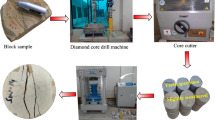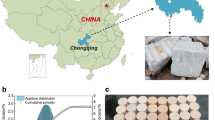Abstract
This study investigated the influence of temperature on the mode I fracture toughness of sandstone using semicircular bend specimens. Fracture characteristics were studied using scanning electron microscopy and other means. The results showed that temperature influenced fracturing in three stages along a temperature gradient. In the low-temperature stage (20–100 °C), fracture toughness increases slowly, with a total increase of approximately 11%. At the medium-temperature stage (100–500 °C), fracture toughness decreases slowly, at a rate of approximately 18%. During the high-temperature stage (500–800 °C), fracture toughness was reduced by approximately 44%. The mode I fracture toughness has a clear temperature threshold (500–600 °C). Below this threshold, the fracture toughness decreases slowly. When the temperature threshold is reached, the fracture toughness decreases sharply. The sharp decrease is mainly caused by the creation of a fragmentation structure. The sandstone experiences more transgranular fracture mechanics in the low-temperature stage compared to the high-temperature stage. Above 100 °C, the mechanisms include transgranular fracturing, intergranular fracturing, thermal cracking, and mutual coupling fracturing. When the temperature exceeds 500 °C, several different fragmentation structures are seen. This research study provides significant data to evaluate fracture characteristics and rock safety and stability after heat treatment.
















Similar content being viewed by others
Abbreviations
- SCB:
-
Semicircular bend
- SEM:
-
Scanning electron microscopy
- ISRM:
-
International Society of Rock Mechanics
- R :
-
Sample radius (mm)
- B :
-
Sample thickness (mm)
- a :
-
Pre-crack length (mm)
- S :
-
Support span (mm)
- P :
-
Load (N)
- D :
-
Sample diameter (mm)
- K IC :
-
Mode I fracture toughness (MPa mm1/2)
- P max :
-
Peak load of specimen failure (N)
- Y′:
-
Dimensionless stress intensity factor
- UCS:
-
Uniaxial compressive strength (MPa)
- T :
-
Temperature (°C)
- σ t :
-
Average UCS (MPa)
- ε t :
-
Average peak strain (10−3)
- E t :
-
Average elastic modulus (GPa)
- S max :
-
Deviation distance (mm)
- XRF:
-
X-ray fluorescence
- XRD:
-
X-ray diffraction
References
Al-Shayea N (2002) Comparing reservoir and outcrop specimens for mixed mode I–II fracture toughness of a limestone rock formation at various conditions. Rock Mech Rock Eng 35(4):271–297
Balme MR, Rocchi V, Jones C, Sammonds PR, Meredith PG, Boon S (2004) Fracture toughness measurements on igneous rocks using a high-pressure, high-temperature rock fracture mechanics cell. J Volcanol Geoth Res 132(2–3):159–172
Chen J, Jiang F (2015) Designing multi-well layout for enhanced geothermal system to better exploit hot dry rock geothermal energy. Renew Energy 74(1):37–48
Cotterell B, Rice JR (1980) Slightly curved or kinked cracks. Int J Fract 16(2):155–169
Funatsu T, Seto M, Shimada H, Matsui K, Kuruppu M (2004) Combined effects of increasing temperature and confining pressure on the fracture toughness of clay bearing rocks. Int J Rock Mech Min Sci 41(6):927–938
Funatsu T, Kuruppu M, Matsui K (2014) Effects of temperature and confining pressure on mixed-mode (I–II) and mode II fracture toughness of Kimachi sandstone. Int J Rock Mech Min Sci 67(2):1–8
Gautam PK, Verma AK, Maheshwar S, Singh TN (2015) Thermomechanical analysis of different types of sandstone at elevated temperature. Rock Mech Rock Eng 49(5):1985–1993
ISRM Testing Commission (1995) Suggested method for determining mode I fracture toughness using cracked chevron notched Brazilian disc (CCNBD) specimens. Int J Rock Mech Mining Sci Geomech Abstr 32(7):57–64
Jung H, Green II HW, Dobrzhinetskaya LF (2004) Intermediate-depth earthquake faulting by dehydration embitterment with negative volume change. Nature 428(1):545–549
Kataoka M, Obara Y, Kuruppu M (2015) Estimation of fracture toughness of anisotropic rocks by semi-circular bend (SCB) Tests Under water vapor pressure. Rock Mech Rock Eng 48(4):1353–1367
Kuruppu MD, Obara Y, Ayatollahi MR, Chong KP, Funatsu T (2014) ISRM-suggested method for determining the mode I fracture toughness using semi-circular bend specimen. Rock Mech Rock Eng 47(1):267–274
Liang C, Wu S, Li X, Xin P (2015) Effects of strain rate on fracture characteristics and mesoscopic failure mechanisms of granite. Int J Rock Mech Min Sci 76:146–154
Mahanta B, Singh TN, Ranjith PG (2016) Influence of thermal treatment on mode I fracture toughness of certain Indian rocks. Eng Geol 210:103–104
Mahanta B, Tripathy A, Vishal V, Singh TN, Ranjith PG (2017) Effects of strain rate on fracture toughness and energy release rate of gas shales. Eng Geol 218:39–49
Mecholsky JJ, Mackin TJ (1988) Fractal analysis of fracture in Ocala chert. J Mater Sci Lett 7(11):1145–1147
Meredith PG, Atkinson BK (1985) Fracture toughness and subcritical crack growth during high-temperature tensile deformation of Westerly granite and Black gabbro. Phys Earth Planet Inter 39(1):33–51
Ouchterlony F (1988) Suggested methods for determining the fracture toughness of rock. Int J Rock Mech Min Sci Geomech Abstr 25(2):71–96
Razvigorova M, Budinova T, Petrova B, Tsyntsarski B, Ekinci E, Ferhat MF (2008) Stem pyrolysis of Bulgarian oil shale kerogen. Oil Shale 25(1):27–36
Sirdesai NN, Mahanta B, Singh TN, Ranjith PG (2016) Elastic modulus of thermally treated fine grained sandstone using non-contact laser extensometer. In: International conference on recent advances in rock engineering, pp 105–109
Sirdesai NN, Singh TN, Ranjith PG, Singh Rajesh (2017) Effect of varied durations of thermal treatment on the tensile strength of red sandstone. Rock Mech Rock Eng 50:205–213
Tian H, Kempka T, Xu N-X, Ziegler M (2012) Physical properties of sandstones after high temperature treatment. Rock Mech Rock Eng 45(6):1113–1117
Tsang C-F, Bernier F, Davies C (2005) Geohydromechanical processes in the excavation damaged zone in crystalline rock, rock salt, and indurate and plastic clays: in the context of radioactive waste disposal. Int J Rock Mech Min Sci 42(1):109–125
Wong T-F, Brace WF (1979) Thermal expansion of rocks: some measurements at high pressure. Tectonophysics 57(2–4):95–117
Wong RHC, Chau KT, Tang CA, Lin P (2001) Analysis of crack coalescence in rock-like materials containing three flaws—part I: experimental approach. Int J Rock Mech Min Sci 38(7):909–924
Xie S, Li E, Li S, Wang J, He C, Yang Y (2015) Surrounding rock control mechanism of deep coal roadways and its application. Int J Mining Sci Technol 25(3):429–434
Yang T, Nie B, Yang D, Zhang R, Zhao C (2012) Experimental research on displacing coal bed methane with supercritical CO2. Saf Sci 50(4):899–902
Yilmaz G (2011) The effects of temperature on the characteristics of kaolinite and bentonite. Sci Res Essays 6(9):1928–1939
Yin T, Li X, Xia K, Huang S (2012) Effect of thermal treatment on the dynamic fracture toughness of laurentian granite. Rock Mech Rock Eng 45(6):1087–1094
Zangerl C, Loew S, Eberhardt E (2006) Structure, geometry and formation of brittle discontinuities in anisotropic crystalline rocks of the Central Gotthard Massif, Switzerland. Eclogae Geol Helv 99(2):271–290
Zhang ZX (2002) An empirical relation between mode I fracture toughness and the tensile strength of rock. Int J Rock Mech Min Sci 39(3):401–406
Zhang QB, Zhao J (2013) Effect of loading rate on fracture toughness and failure micromechanisms in marble. Eng Fract Mech 102:288–309
Zhang ZX, Yu J, Kou SQ, Lindqvist P-A (2001) Effects of high temperatures on dynamic rock fracture. Int J Rock Mech Min Sci 38(2):211–225
Zhao Y-S, Meng Q-R, Kang T, Zhang N, Xi B (2008) Micro-CT experimental technology and meso-investigation on thermal fracturing characteristics of granite. Chin J Rock Mechan Eng 27(1):28–34 (in Chinese)
Zuo J-P, Xie H-P, Dai F, Ju Y (2014) Three-point bending test investigation of the fracture behavior of siltstone after thermal treatment. Int J Rock Mech Min Sci 70(9):133–143
Acknowledgements
This study was supported by the National Key Basic Research Development Program of China (973 Program) (Grant No. 2014CB239200) and the National Natural Science Foundation of China (Grant No. 51574173).
Author information
Authors and Affiliations
Corresponding author
Rights and permissions
About this article
Cite this article
Feng, G., Kang, Y., Meng, T. et al. The Influence of Temperature on Mode I Fracture Toughness and Fracture Characteristics of Sandstone. Rock Mech Rock Eng 50, 2007–2019 (2017). https://doi.org/10.1007/s00603-017-1226-y
Received:
Accepted:
Published:
Issue Date:
DOI: https://doi.org/10.1007/s00603-017-1226-y




